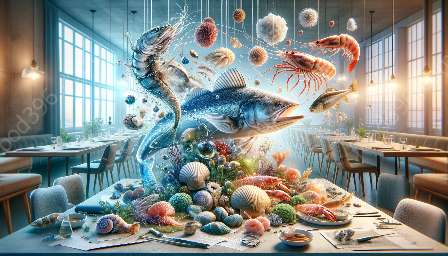Seafood is a valuable natural resource that provides sustenance and livelihoods for countless people around the world. To ensure the continued availability of seafood and the health of our marine ecosystems, sustainable management practices are essential. This topic cluster explores the biology and physiology of seafood, the science behind sustainable seafood management, and its real-world applications.
Biology and Physiology of Seafood
The biology and physiology of seafood play a crucial role in understanding and managing marine resources. Understanding the life cycles, reproductive patterns, and growth rates of various species is critical for responsible resource management.
For instance, knowledge of fish migration patterns helps in the creation of marine protected areas and sustainable fishing regulations during critical breeding and spawning seasons. The study of the nutritional composition and health benefits of seafood is also essential for promoting balanced and sustainable diets.
The Science of Sustainable Seafood Management
Sustainable seafood management is guided by scientific principles and research to ensure that marine resources are utilized in a manner that maintains their long-term productivity. This involves assessing the health of fish stocks, monitoring fishing practices, and implementing conservation measures to mitigate environmental impacts.
Fisheries biologists and marine scientists work together to collect data on species populations and ecosystem dynamics, allowing for informed decision-making in resource management. Additionally, advancements in technology enable the tracking of fishing vessels, reducing illegal, unreported, and unregulated (IUU) fishing that threatens the sustainability of seafood resources.
Embracing Innovation and Best Practices
The sustainable management of seafood resources involves embracing innovative technologies and best practices to minimize waste and environmental harm. Aquaculture, or the farming of seafood, offers promising solutions to meet the growing demand for seafood while reducing the impact on wild fish populations.
Newly developed aquaculture techniques, such as recirculating aquaculture systems and integrated multitrophic aquaculture, strive to minimize the environmental footprint and promote efficient resource use. Innovations in seafood processing and packaging also focus on reducing energy consumption and waste generation.
Real-World Applications and Conservation Efforts
Real-world applications of sustainable seafood management encompass a range of initiatives aimed at protecting and restoring marine ecosystems. Initiatives such as marine spatial planning, which involves systematic organization of human activities, including fishing, to ensure the sustainable use of marine resources, are gaining traction worldwide.
Furthermore, the development of certification programs, such as the Marine Stewardship Council (MSC) and Aquaculture Stewardship Council (ASC), provides consumers with assurance that the seafood they purchase has been sourced sustainably. These programs incentivize fisheries and aquaculture operations to adhere to stringent sustainability standards and practices.
Conclusion
The sustainable management of seafood resources requires a comprehensive understanding of the biology, physiology, and science behind seafood. By employing innovative practices, embracing scientific knowledge, and advocating for conservation efforts, we can protect our marine resources for future generations while meeting the global demand for seafood.

